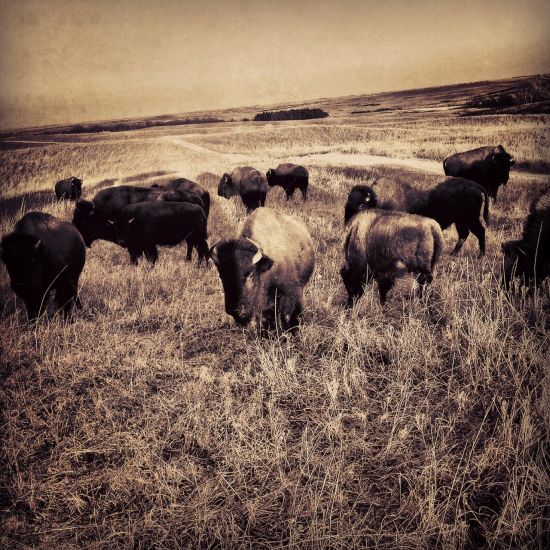Today’s Flyover People column as seen in The Emporia Gazette:
MAXWELL WILDLIFE REFUGE
A fragile white moon hung against a blue winter sky. Below that nearly-full moon a dozen bison grazed.
Atop a nearby ridge, seven head of elk, “the bachelors,” looked on. The elk and the winter grasses were the same shade of tan. Two of the elk were sparring on the hill and I wondered how often an elk’s antlers get tangled up with another. Surely that happens, doesn’t it?
On a crisp December afternoon, seven of us and a driver were out on the Maxwell Wildlife Refuge in McPherson County. Jim and Cindy Griggs, who live in McPherson and are frequent visitors to the refuge, had arranged our photography tour.
We rode in a tram, a long trailer pulled by a pickup. Padded benches faced outward for viewing. Plexiglass windows provided some protection from the light breeze, but it was basically an open-air conveyance. On this 30-degree day, the air was cold enough to see our exhalations.
But we were on safari. In Kansas.
Maxwell Wildlife Refuge is located in McPherson County, six miles north of Canton along the Prairie Trail Scenic Byway. The Prairie Trail Scenic Byway is 56 miles long and goes from Canton to Lindsborg and Marquette. The byway takes travelers past the Maxwell Wildlife Refuge, Kanopolis State Park, and Mushroom Rock State Park.
This wildlife refuge got its start in 1943 when the Henry Maxwell Estate donated 4 square miles to the Kansas Forestry, Fish and Game Commission. A natural prairie preserve had been a dream of John Gault Maxwell (Henry’s father) who had settled in the area in 1859. Bison and elk were placed on the land in 1951.
The land is in the Smoky Hill region of Kansas, so the hills are rolling and the grass can grow knee-high, waist-high.
We didn’t get very close to the elk, and I guess that’s why long camera lenses were invented, but at one stop on the tour, a herd of about 25 bison came close to check us out.
The animals were in small groups, but overall there were 180 bison on the refuge and 80 head of elk.
Stan Stephenson, our driver, said the refuge held their annual sale in mid-November. They sell animals each year to keep the herds at a level that the land can support. Stephenson said that this year 66 bison were sold, which is about the number of calves born each year.
They sell the cows that haven’t calved as well as the ones who have late-season calves. “They’ll cull those out of the herd,” he said.
I asked Stephenson for his job title at the refuge, and he said he was “just a wrangler.” He’s retired he said, a volunteer. “I find every excuse I can to get out here.”
He said of the bison, “When we come out here in the morning to feed them, when it’s really cold out, they’re prancing and dancing.”
That I’d like to see. These heavy creatures don’t look like prancers and dancers.
As we drove, we saw a wallow here, a wallow there, everywhere a wallow. None of the bison were wallowing, but it wasn’t for lack of opportunity.
We were at the refuge in the late afternoon. The sun’s rays, cast at an angle, skipped across the grasses and turned them golden.
It was a cold day for the tour, but still a very enjoyable ride in the hills. I’d like to hit the refuge during the green months, the warm months. Maybe next time I’ll catch bison in their wallows.
Tours are available year-round by reservation. A tour takes about an hour and costs $8 for adults, $5 for children. No charge for children 4-years and under. For more information call (620)-628-4455, or visit their website: www.cyberkraft.com/maxwell/
Copyright 2014 ~ Cheryl Unruh
Follow Flyover People on Facebook.
And… the Flyover People book is now available on Kindle for your reading enjoyment. Click here.

“a wallow here, a wallow there, everywhere a wallow. None of the bison were wallowing, but it wasn’t for lack of opportunity.” Gee, I wish I’d written that. A delightful column made even more so by the fact that we were there watching you scribble notes and snap shots with your cell phone.
Thanks, Tom. 🙂